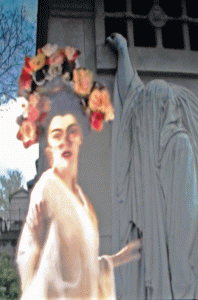« Reviews
Leslie Gabaldón and María Cristina Carbonell

Maria Cristina Carbonell, La Voyeuse (2007), 3 minutes, HD Video Transfer into DVD. Courtesy of the artist and Dot Fiftyone Gallery.
Dot Fiftyone Gallery, Miami
By Irina Leyva-Pérez
Dot Fiftyone presented solo exhibitions of two female artists: Leslie Gabaldón’s Goody Two-Shoes and María Cristina Carbonell’s An Idyllic World. On the first floor, Leslie Gabaldón continued with her theme of domestic life in her new series Goody Two-Shoes. The title is a phrase that has become part of the popular culture used to describe, in an ironic and pejorative way, someone who is ‘excessively good.’ Gabaldon, inspired by this phrase in an autobiographical manner, made life-sized cutouts of herself wearing only underwear, in the tradition of paper dolls waiting to be dressed in their various outfits. These realistic-looking “paper dolls” greet you at the central wall of the exhibition, and behind them are hanging paper dresses in a 50s fashion, ready to be used. By mimicking a traditional game for girls, she is talking about the face many women show to society, presenting themselves as the image of perfection. Gabaldón, in a revisionist fashion, questions the motives behind such ‘virtuousness’. Is it real, or is it part of the obsessive and perfectionist contemporary society? She is criticizing the way many women are embarking on a pursuit for an unreal perfection at any cost, pushing themselves to the very limit no matter what they have to sacrifice in the process. As Machiavelli would say: the end justifies the means.
On the second floor of the gallery, María Cristina Carbonell shows a different side of the coin in An Idyllic World. Through her videos she brings up to life a cosmogony of her own with very unique characters. Her videos have a dream-like atmosphere in which real people coexist with what seem like ghosts. One of her main characters is a woman in geisha regalia that ‘walks’ and ‘flies’ around visitors at Père Lachaise Cemetery in Paris, then again in a garden, and later in a tea house. Carbonell is, in a way, erasing the line between reality and fiction, mixing together the two dimensions. The ‘geisha’ has a mask on her face, hiding her real identity from the viewer. This is a resource that Carbonell uses throughout her work by playing different characters. She is the protagonist of all her videos and is constantly changing hats: from an almost naked woman, to the pole of a nightclub, to a geisha ghost. All these characters share some trait of hers; they are showing the many facets of her personality, much like the ying and yang we all have inside. Her imagery is a compilation of universal fragments: from the East to the West, from the North to the South.

Leslie Gabaldón, Vero from Calling Cards series 1/1, 2010, ink jet print on wood-board, 30" x 21". Courtesy of the artist and Dot Fiftyone Gallery.
Another video, Dream Lips, appears as a sweet game between a woman and a girl, in which they play to put on putty and plump lips, similar to what the existing ideal of beauty dictates, reproduced even in dolls. This seemingly naïve exchange between the girl and the woman could scar the girl by setting her physical ideal. It could be seen as a mother not just playing with her daughter but also passing on her own expectations.
Although the works of Gabaldón and Carbonell are clearly different from each other, there are points of contact. In a way both are commenting about their intimate lives and the way they perceive themselves in a social environment. Both are using their own image as an unmistakable self-reference. While Gabaldón is focusing on her private life set within a domestic environment, Carbonell sees herself as a part of the whole world, as a woman of many phases and places.
(March 13 - April 30, 2010)
Filed Under: Reviews


































